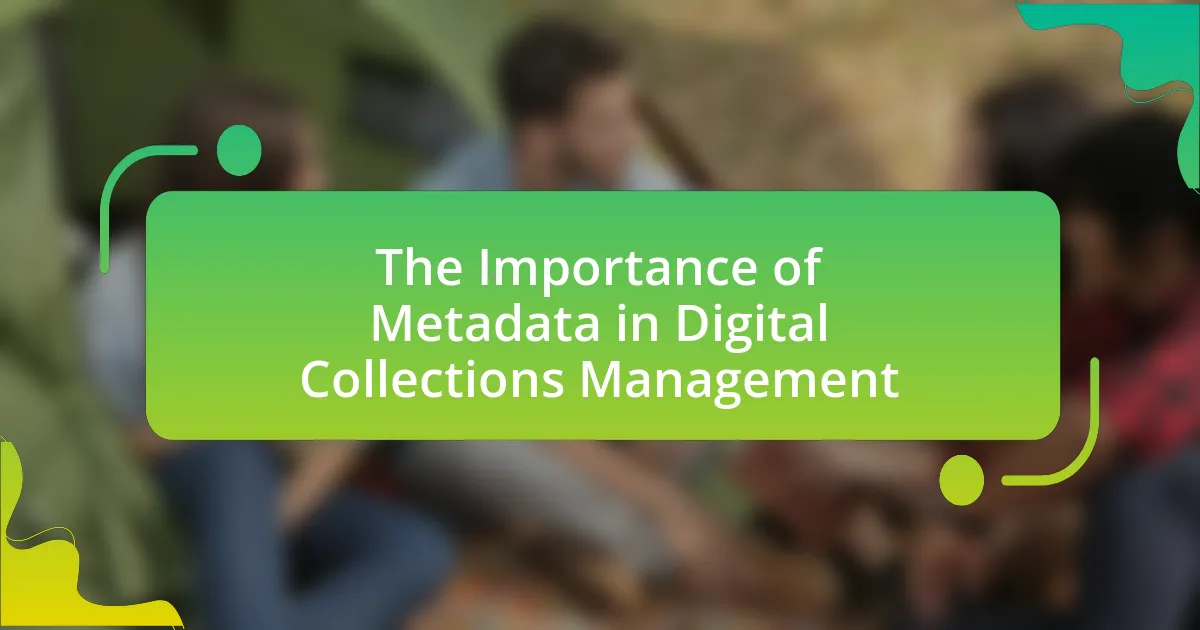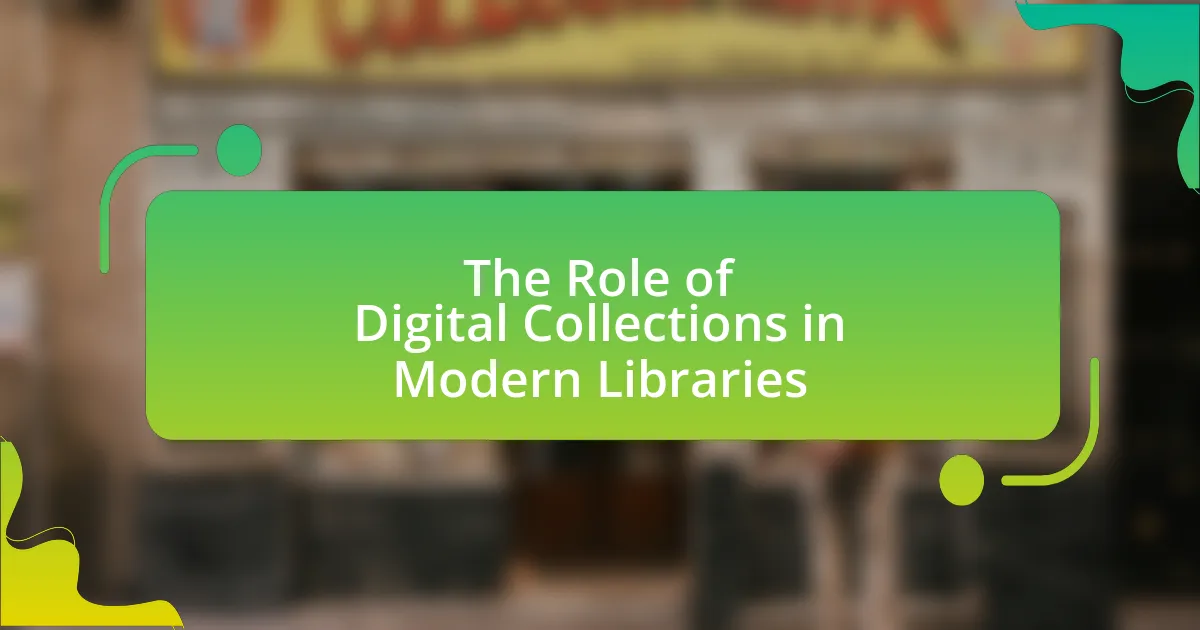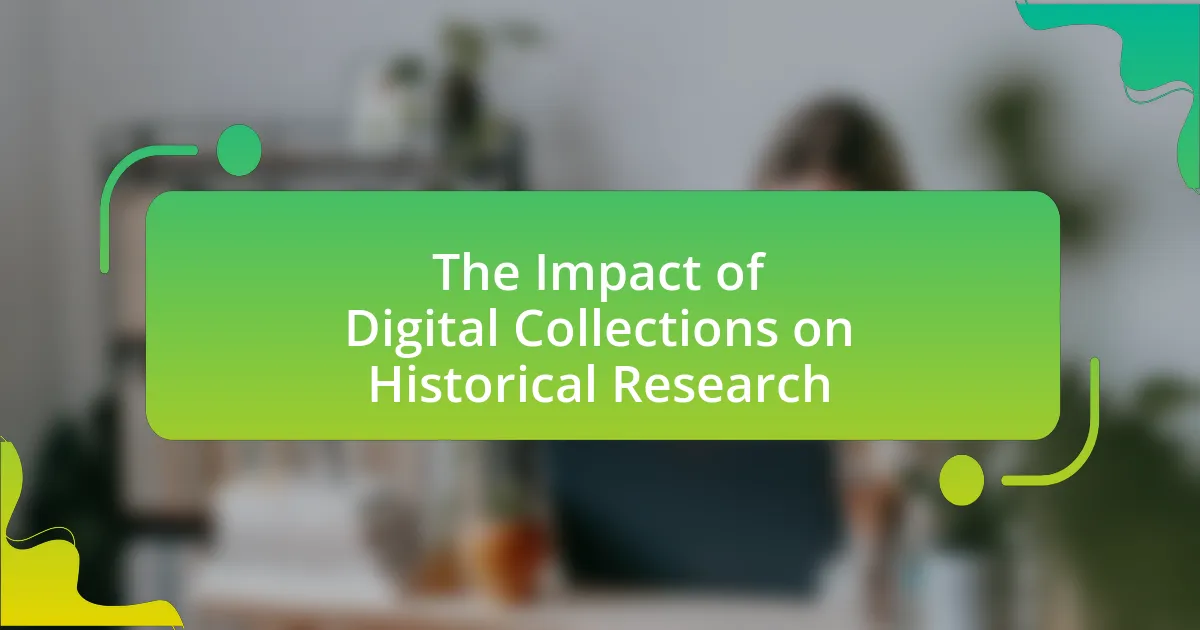The article focuses on current trends in digital collection development for special libraries, highlighting user-centered design, artificial intelligence integration, and the emphasis on open access resources. It discusses how technological advancements enhance accessibility and improve metadata management, while also examining specific technologies adopted by special libraries, such as integrated library systems and cloud computing solutions. The role of user engagement in shaping collections, strategies for assessing user needs, and the importance of collaboration among libraries are also explored. Additionally, the article addresses challenges faced by special libraries, including budget constraints and technical issues, while providing best practices for ensuring the sustainability and quality of digital collections.
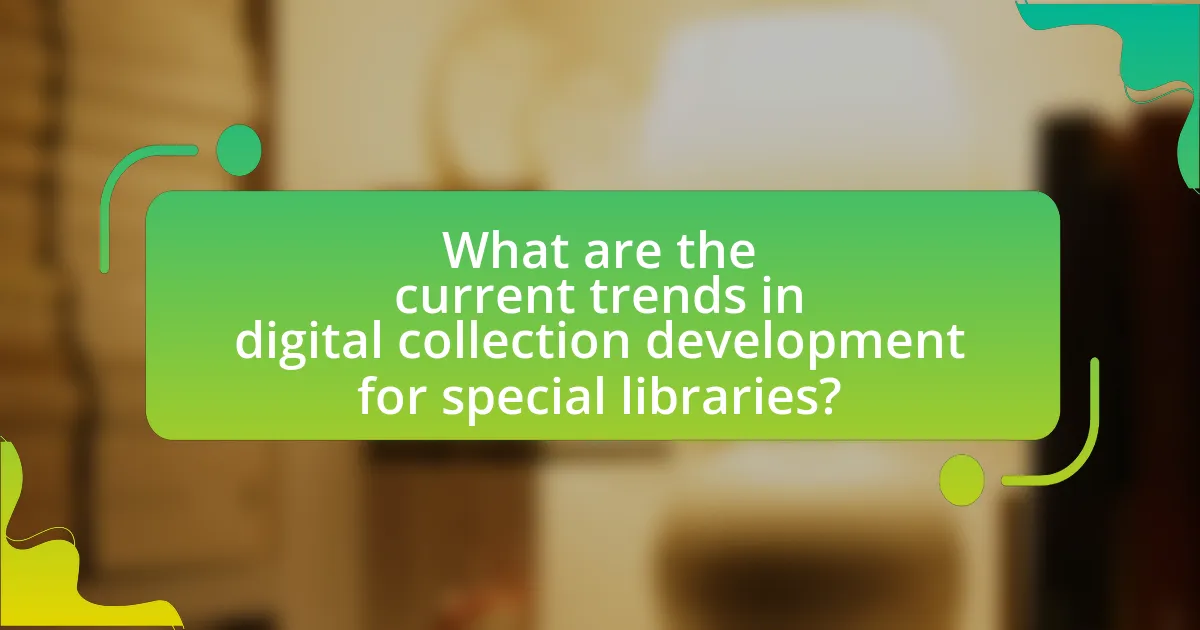
What are the current trends in digital collection development for special libraries?
Current trends in digital collection development for special libraries include the increased focus on user-centered design, the integration of artificial intelligence for enhanced search capabilities, and the emphasis on open access resources. User-centered design prioritizes the needs and preferences of library users, leading to more relevant and accessible collections. The integration of artificial intelligence allows for improved metadata management and personalized user experiences, facilitating easier access to information. Additionally, the push for open access resources reflects a broader movement towards transparency and accessibility in scholarly communication, enabling libraries to provide users with a wider range of freely available materials. These trends are supported by research indicating that user engagement and technological advancements are critical for the evolution of digital collections in special libraries.
How are technological advancements influencing digital collection development?
Technological advancements are significantly influencing digital collection development by enhancing accessibility, improving metadata management, and facilitating the integration of diverse formats. For instance, the adoption of cloud storage solutions allows libraries to store vast amounts of digital content, making it easily accessible to users from anywhere. Additionally, advancements in artificial intelligence and machine learning improve metadata generation and organization, which streamlines the process of cataloging and retrieving digital assets. According to a 2021 study by the American Library Association, 78% of libraries reported that technology has enabled them to expand their digital collections more efficiently, demonstrating the direct impact of these advancements on collection development strategies.
What specific technologies are being adopted in special libraries?
Special libraries are adopting technologies such as integrated library systems (ILS), digital asset management systems, and cloud computing solutions. Integrated library systems streamline cataloging, circulation, and user management, enhancing operational efficiency. Digital asset management systems facilitate the organization and retrieval of digital collections, which is crucial for special libraries that often house unique materials. Cloud computing solutions provide scalable storage and access to resources, enabling remote access and collaboration. These technologies support the evolving needs of special libraries in managing and delivering specialized information effectively.
How do these technologies enhance user experience in digital collections?
Technologies enhance user experience in digital collections by providing intuitive interfaces, advanced search capabilities, and personalized content delivery. Intuitive interfaces simplify navigation, allowing users to easily access and explore collections. Advanced search capabilities, such as natural language processing and machine learning algorithms, enable users to find relevant materials quickly and efficiently. Personalized content delivery, through recommendation systems, tailors the user experience based on individual preferences and behaviors, increasing engagement and satisfaction. These enhancements lead to a more efficient and enjoyable interaction with digital collections, ultimately fostering greater user retention and utilization.
What role does user engagement play in digital collection development?
User engagement is crucial in digital collection development as it directly influences the relevance and usability of the collections. Engaged users provide valuable feedback, which helps curators understand user needs and preferences, leading to more targeted acquisitions and enhancements. For instance, a study by the American Library Association found that libraries that actively involve users in collection decisions see a 30% increase in user satisfaction and usage rates. This demonstrates that user engagement not only shapes the collection but also fosters a sense of ownership and community among users, ultimately enhancing the effectiveness of digital collections in special libraries.
How can special libraries assess user needs for digital collections?
Special libraries can assess user needs for digital collections through surveys, focus groups, and usage analytics. Surveys allow libraries to gather quantitative data on user preferences and interests, while focus groups provide qualitative insights into user experiences and expectations. Usage analytics, such as tracking which digital resources are accessed most frequently, help libraries understand actual user behavior and inform collection development. Research indicates that libraries employing these methods can better align their digital collections with user needs, enhancing resource relevance and user satisfaction.
What strategies can be implemented to improve user engagement?
To improve user engagement in special libraries, implementing personalized content delivery is essential. Personalization can be achieved through user data analysis, allowing libraries to tailor resources and recommendations based on individual preferences and behaviors. Research indicates that personalized experiences can increase user satisfaction and engagement by up to 50%, as users are more likely to interact with content that resonates with their interests. Additionally, integrating interactive features such as virtual events, webinars, and social media engagement fosters community involvement and encourages users to participate actively. These strategies collectively enhance user engagement by creating a more relevant and interactive library experience.
Why is collaboration important in digital collection development?
Collaboration is important in digital collection development because it enhances resource sharing, expertise, and innovation among libraries and institutions. By working together, libraries can pool their resources, allowing for a more diverse and comprehensive digital collection that meets the varied needs of users. For instance, collaborative projects like the Digital Public Library of America have demonstrated that partnerships can lead to the creation of extensive digital archives that individual libraries may not be able to achieve alone. Additionally, collaboration fosters the exchange of best practices and technological advancements, which can improve the overall quality and accessibility of digital collections.
What types of partnerships are beneficial for special libraries?
Collaborative partnerships with academic institutions, government agencies, and private sector organizations are beneficial for special libraries. These partnerships enhance resource sharing, access to specialized knowledge, and funding opportunities. For instance, collaborations with academic institutions can facilitate joint research projects, allowing libraries to expand their digital collections and improve access to unique resources. Partnerships with government agencies often lead to grants and funding for digital initiatives, while private sector collaborations can provide technological support and innovative solutions for digital collection development. Such strategic alliances ultimately strengthen the library’s role in serving its community and advancing its mission.
How can collaboration enhance resource sharing among libraries?
Collaboration enhances resource sharing among libraries by facilitating access to a broader range of materials and services. When libraries work together, they can pool their collections, allowing patrons to access resources that may not be available in their home library. For instance, interlibrary loan systems and consortia agreements enable libraries to share physical and digital materials efficiently. According to a study by the American Library Association, libraries that participate in collaborative networks report a 30% increase in resource availability for their users. This collaborative approach not only maximizes the use of existing resources but also fosters innovation in service delivery, ultimately benefiting the communities they serve.
What challenges do special libraries face in digital collection development?
Special libraries face several challenges in digital collection development, including limited budgets, evolving technology, and the need for specialized content. Budget constraints often restrict the acquisition of digital resources, making it difficult to keep collections current and comprehensive. Additionally, the rapid pace of technological advancements requires libraries to continuously adapt their systems and platforms, which can strain resources and expertise. Furthermore, the demand for specialized content necessitates collaboration with niche publishers and content creators, which can complicate licensing agreements and access rights. These factors collectively hinder the effective development of digital collections in special libraries.
How do budget constraints impact digital collection initiatives?
Budget constraints significantly limit the scope and effectiveness of digital collection initiatives. When funding is restricted, libraries may struggle to acquire new digital resources, maintain existing collections, or invest in necessary technology and infrastructure. A study by the American Library Association found that 60% of libraries reported budget cuts affecting their ability to expand digital collections, leading to reduced access for users and diminished overall service quality. Consequently, budget limitations can hinder the development of comprehensive digital archives, impacting the long-term sustainability and growth of special libraries.
What are the common technical challenges encountered?
Common technical challenges encountered in digital collection development for special libraries include data management issues, interoperability problems, and resource allocation constraints. Data management issues arise from the need to organize, store, and retrieve large volumes of digital content efficiently. Interoperability problems occur when different systems and platforms fail to communicate effectively, hindering seamless access to resources. Resource allocation constraints often limit the ability to invest in necessary technology and staff training, impacting the overall effectiveness of digital collections. These challenges are supported by findings from the “Digital Libraries: Challenges and Opportunities” report by the International Federation of Library Associations, which highlights the importance of addressing these technical barriers to enhance digital library services.
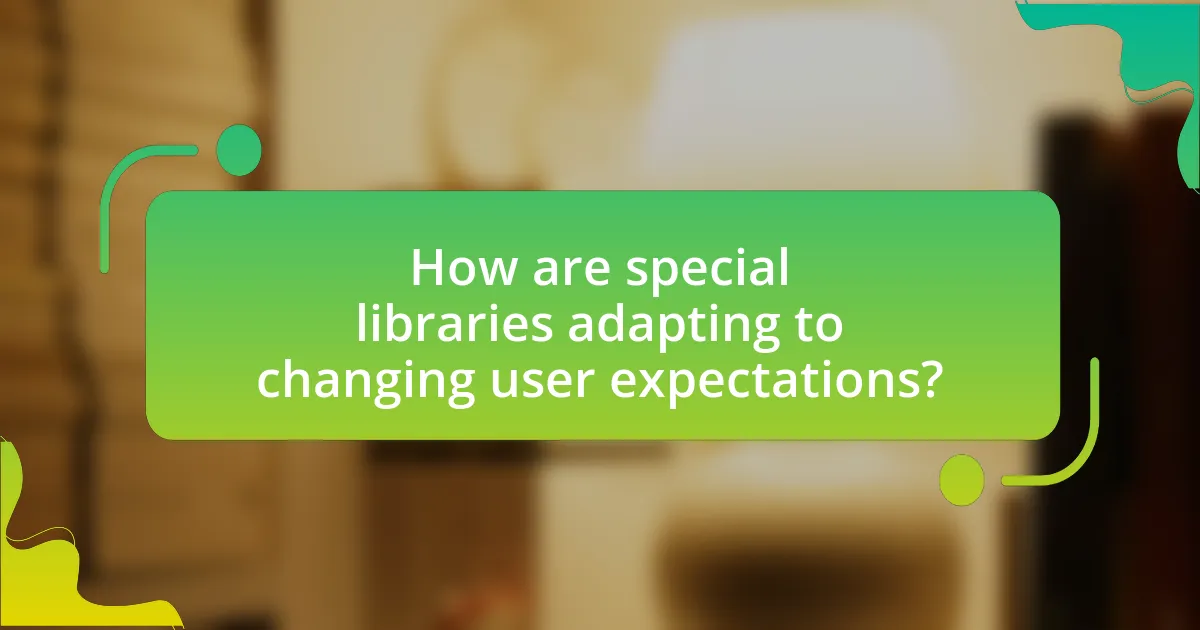
How are special libraries adapting to changing user expectations?
Special libraries are adapting to changing user expectations by enhancing digital access to resources and incorporating user-centered services. They are increasingly offering online databases, e-books, and digital archives to meet the demand for immediate access to information. For instance, a survey by the Special Libraries Association found that 70% of special libraries have expanded their digital collections in response to user preferences for remote access. Additionally, these libraries are implementing user feedback mechanisms to tailor services and collections, ensuring they align with the evolving needs of their patrons.
What are the emerging user expectations for digital collections?
Emerging user expectations for digital collections include enhanced accessibility, personalized experiences, and seamless integration with other digital resources. Users increasingly demand that digital collections be available across multiple devices and platforms, ensuring they can access materials anytime and anywhere. Additionally, personalization features, such as tailored recommendations based on user behavior, are becoming essential as users seek content that aligns with their interests. Furthermore, the integration of digital collections with other digital tools and platforms, such as social media and collaborative tools, is expected to facilitate a more engaging and interactive experience. These expectations are supported by studies indicating that 78% of users prefer platforms that offer personalized content and 65% value accessibility across devices.
How can special libraries stay ahead of these expectations?
Special libraries can stay ahead of expectations by actively adopting emerging technologies and continuously updating their digital collections to meet user needs. By integrating artificial intelligence and machine learning, special libraries can enhance search capabilities and personalize user experiences. Additionally, conducting regular assessments of user feedback and trends in information consumption allows libraries to adapt their collections and services accordingly. For instance, a study by the American Library Association found that libraries that implemented user-centered design principles saw a 30% increase in user satisfaction. This proactive approach ensures that special libraries remain relevant and responsive to the evolving demands of their patrons.
What role does accessibility play in meeting user expectations?
Accessibility is crucial in meeting user expectations as it ensures that digital collections are usable by all individuals, including those with disabilities. By adhering to accessibility standards, such as the Web Content Accessibility Guidelines (WCAG), special libraries can provide equitable access to information, which enhances user satisfaction and engagement. Research indicates that 15% of the global population experiences some form of disability, highlighting the necessity for inclusive design. Furthermore, accessible digital collections can lead to increased usage and patron loyalty, as users are more likely to return to resources that accommodate their needs effectively.
How is data analytics shaping digital collection strategies?
Data analytics is significantly shaping digital collection strategies by enabling libraries to make data-driven decisions that enhance user engagement and resource allocation. By analyzing user behavior and preferences, libraries can identify which digital resources are most utilized, allowing them to tailor their collections to meet the specific needs of their patrons. For instance, a study by the American Library Association found that libraries employing data analytics saw a 30% increase in user satisfaction due to more relevant collections. This strategic approach not only optimizes resource management but also fosters a more personalized user experience, ultimately leading to increased usage and support for digital collections.
What types of data should special libraries collect for effective decision-making?
Special libraries should collect user engagement data, resource usage statistics, and demographic information for effective decision-making. User engagement data, such as search queries and feedback, helps libraries understand user needs and preferences. Resource usage statistics, including circulation and access frequency, provide insights into which materials are most valuable to patrons. Demographic information allows libraries to tailor their collections and services to meet the specific needs of their community. Collectively, these data types enable informed decisions that enhance library services and resource allocation.
How can data analytics improve collection relevance and usage?
Data analytics can improve collection relevance and usage by enabling libraries to analyze user behavior and preferences, thereby tailoring collections to meet specific needs. By examining data such as search queries, borrowing patterns, and user feedback, libraries can identify which materials are most sought after and adjust their acquisitions accordingly. For instance, a study by the American Library Association found that libraries utilizing data analytics saw a 30% increase in user engagement with collections, demonstrating the effectiveness of data-driven decision-making in enhancing relevance and usage.

What best practices should special libraries follow in digital collection development?
Special libraries should follow best practices in digital collection development that include assessing user needs, selecting diverse and relevant materials, ensuring metadata quality, and implementing sustainable preservation strategies. Assessing user needs involves conducting surveys and focus groups to understand the specific requirements of the library’s audience, which helps in curating a collection that meets their demands. Selecting diverse and relevant materials ensures that the collection reflects a wide range of perspectives and subjects, enhancing its value to users. Ensuring metadata quality is crucial for discoverability; accurate and comprehensive metadata allows users to find and access resources efficiently. Implementing sustainable preservation strategies, such as regular backups and format migrations, protects digital assets from obsolescence and data loss. These practices are supported by the Digital Library Federation’s guidelines, which emphasize user-centered approaches and the importance of metadata in digital collections.
How can special libraries ensure the sustainability of digital collections?
Special libraries can ensure the sustainability of digital collections by implementing robust digital preservation strategies. These strategies include regular data backups, the use of standardized formats for long-term accessibility, and the establishment of clear metadata standards to enhance discoverability. For instance, the Library of Congress emphasizes the importance of using open formats and maintaining multiple copies in different geographic locations to mitigate risks of data loss. Additionally, engaging in collaborative partnerships with other institutions can provide shared resources and expertise, further strengthening the sustainability of digital collections.
What funding models are effective for sustaining digital collections?
Effective funding models for sustaining digital collections include grants, institutional support, partnerships, and subscription-based models. Grants from government agencies and foundations provide essential financial resources, as evidenced by the National Endowment for the Humanities, which has funded numerous digital projects. Institutional support from universities or libraries ensures ongoing operational funding, while partnerships with private organizations can leverage additional resources and expertise. Subscription-based models, where users pay for access to digital content, have also proven effective, as seen in platforms like JSTOR, which generates revenue through institutional subscriptions. These models collectively enhance the sustainability of digital collections by diversifying funding sources and ensuring continuous access to resources.
How can libraries create a long-term digital preservation strategy?
Libraries can create a long-term digital preservation strategy by implementing a comprehensive framework that includes regular assessment of digital assets, selection of appropriate preservation formats, and the establishment of a sustainable funding model. This approach ensures that digital materials remain accessible and usable over time. For instance, the Digital Preservation Coalition emphasizes the importance of using open standards and formats to mitigate risks associated with technological obsolescence. Additionally, libraries should engage in collaborative partnerships with other institutions to share resources and expertise, as demonstrated by initiatives like the LOCKSS (Lots of Copies Keep Stuff Safe) program, which allows libraries to preserve and provide access to digital content collectively.
What are the key considerations for selecting digital content?
Key considerations for selecting digital content include relevance, quality, accessibility, and cost. Relevance ensures that the content aligns with the needs and interests of the target audience, which is crucial for special libraries aiming to serve specific communities. Quality pertains to the accuracy, credibility, and overall presentation of the content, as high-quality materials enhance user experience and trust. Accessibility involves ensuring that the content is easily discoverable and usable by all potential users, including those with disabilities, which is essential for compliance with legal standards like the Americans with Disabilities Act. Cost considerations involve evaluating the financial implications of acquiring and maintaining digital content, ensuring that it fits within the library’s budget while providing value to users. These factors collectively guide the selection process, ensuring that the digital content meets the strategic goals of the library and serves its community effectively.
How can special libraries evaluate the quality of digital resources?
Special libraries can evaluate the quality of digital resources by employing criteria such as accuracy, authority, currency, relevance, and usability. These criteria help ensure that the digital resources meet the specific needs of their users and maintain high standards of information integrity. For instance, accuracy involves verifying the correctness of the content, while authority assesses the credibility of the source, often looking for established authors or organizations in the field. Currency ensures that the information is up-to-date, which is crucial in rapidly changing fields. Relevance evaluates how well the resource meets the needs of the library’s target audience, and usability examines the ease of access and navigation of the digital resource. By systematically applying these criteria, special libraries can effectively assess and select high-quality digital resources for their collections.
What criteria should be used for content selection in digital collections?
Content selection in digital collections should be based on criteria such as relevance, authenticity, accessibility, and diversity. Relevance ensures that the content aligns with the mission and goals of the library, while authenticity guarantees the accuracy and trustworthiness of the materials. Accessibility focuses on making content available to a wide audience, including those with disabilities, and diversity promotes the inclusion of various perspectives and voices. These criteria are essential for creating a comprehensive and user-centered digital collection that meets the needs of its users.
What practical tips can enhance digital collection development in special libraries?
To enhance digital collection development in special libraries, it is essential to conduct a thorough needs assessment to identify user requirements and gaps in existing collections. This assessment should involve surveys, interviews, and usage statistics to gather data on what users seek. Additionally, establishing partnerships with content providers can expand access to diverse digital resources, ensuring that collections are comprehensive and relevant. Implementing robust metadata standards improves discoverability and usability of digital assets, facilitating easier access for users. Furthermore, continuous evaluation and feedback mechanisms should be integrated to adapt collections based on changing user needs and technological advancements. These strategies are supported by research indicating that user-centered approaches significantly improve the effectiveness of digital collections in special libraries.




